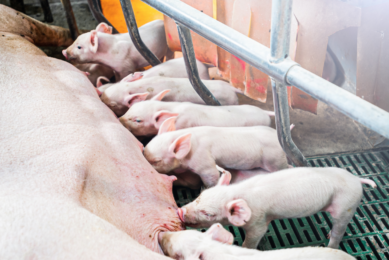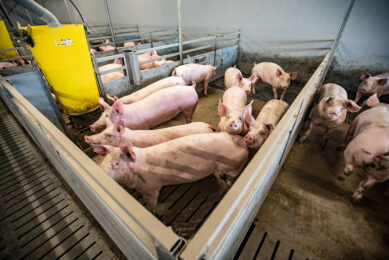Canada: Natural advantages but recent hardships

Taking a snapshot of the Canadian pork industry in 2010, one would be likely to conclude that it is has some serious problems. Pig numbers have been falling steadily from their peak in 2005/6 following more than three years of continuous financial losses. What has been happening in the Canadian pig industry – and what are the prospects for the future?
©
©
Comparing Canadian census data from January 1st 2005 and 2010 (Table 1), it can be seen that total pig numbers have fallen by 21.5% during this period. At the same time, the number of farms with pigs reporting for the census fell by a massive 41.7%, from 12,615 to 7,360. These issues facing the industry have been described in a previous Pig Progress article, Canadian producers fight for survival (Vol. 24, No. 10, 2008).
©
Since then, the North American pork industry has been seriously affected by the H1N1 (swine flu) scare which affected exports, while the strength of the Canadian dollar continues to negatively impact competitiveness. In addition, the effects of US Country of Origin Labelling (COOL) legislation have been severe, with exports of live pigs to the USA declining to 6.4 million in 2009 compared to a peak of nearly 10 million in 2007. As a result, the Canadian industry remains in a crisis and is likely to contract further in future.
©
Recognising that the industry was likely to continue contracting, the Canadian Pork Council (CPC), the national producer representative body, developed a Canadian Pork Industry Strategic Transition Plan which it presented to the federal government in the summer of 2009. It suggested that total production of pigs would decline from 31 million in 2008 to just 25.5 million in 2014. A key part of the plan was to capture more of the domestic market, where imports – mainly from the USA – now represent nearly 25% of consumption.
©
Discussions with government resulted in two support measures for producers that have been implemented over the last six to nine months. The first, the Hog Farm Transition Program, provided CAN$75 million (US$73.1 million) for producers prepared to exit production and keep their facilities free of pigs for a period of three years. The process involved producers bidding for the available funds, which have been allocated in four tranches. In order for bids to be comparable for different types of animals and farms, they were made on the basis of Animal Unit Equivalents (AEUs). The first two tenders resulted in the removal of nearly 67,000 sows, which means that, by the completion of the programme, around 130,000 sows will have been removed.
©
©
The second part of the government assistance involves long term loans provided by Canadian banks but substantially guaranteed by the federal government. Producers have had to show a viable business plan, which has been a problem for many, given the poor economic circumstances. As a result, this initiative has had limited success and has been widely criticised by industry leaders. In addition to direct help for producers, the government also provided CAN$17 million (US$16.6 million) in funding for marketing activities, primarily in export markets.
©
Natural advantages
Despite all its current challenges, Canada has many advantages that make it a natural place to produce pigs and other livestock. With a recent FAO report predicting that global annual meat production is expected to expand from 228 million tonnes currently to 463 million tonnes by 2050, it is difficult to imagine that Canada will not be a more important source of animal protein in the future. With ample supplies of grain, an abundant water supply and many other fundamental advantages, it seems very likely that, in the longer term, the pork industry will expand again.
©
An excellent health status is a huge benefit in achieving high performance levels and low production costs. Canada as a country has been free from diseases such as Food-and-Mouth Disease (FMD) and Classical Swine Fever (CSF) for many years and herd health status is high, especially in the prairie provinces. Disease control and biosecurity is facilitated by low pig density across much of the country, making it possible to maintain freedom from production limiting diseases such as PRRS and Mycoplasma. Indeed, many international breeding companies, such as PIC and Hypor, have located nucleus farms in western Canada because of the ability to site farms well away from other pigs. Production efficiency in Canada compares well with competitor countries, although unfortunately there is little data for accurate benchmarking available.
©
My experience and evidence from some herd recording programmes suggests that breeding herds average in the region of 24 pigs weaned/sow/year, while an increasing number of producers, although still few in number, are breaking the 30-pig barrier.
©
Strong dollar affects competitiveness Production cost, which varies somewhat depending on province, is currently in the region of CAN$1.40 to $1.50/kg (or US$1.36 to $1.46), which is extremely competitive by international standards. However, the strength of the Canadian dollar, especially relative to its US counterpart, has meant that the US has been more competitive in international markets, making life extremely difficult for Canadian processors. In addition, the price paid by processors to producers for the pigs they buy is based on published US prices, such as the Iowa/ Minnesota price published by the USDA, which means that the strong Canadian dollar reduces what Canadian processors pay. At the current time (end of February), the base price is only CAN$1.25/kg (US$1.22/kg), leaving producers with a CAN$20/pig (US$19.50/pig) loss, whereas producers in the USA are approaching break even point. Canada’s broader economy is in much better shape than that of the USA, largely due to its robust banking system, which escaped the world financial crisis largely unscathed. Its currency is also driven by natural resource prices, especially oil and gold. Despite its economic dependency on the USA, its biggest export market by far, it is likely to recover from the economic downturn more quickly and, as a result, the Canadian dollar is likely to maintain its strength into the foreseeable future. The implication for the pork industry in the next few years is that production capacity is likely to be lost, while the US industry will take an increasing share of world export markets.
©
Adding value
In the new environment that the Canadian industry finds itself, there must be a focus on creating additional value in the supply chain, especially through selling premium priced products in export markets. Canada has an enviable reputation for pork quality and food safety, but does not realise high enough value for its products. In the domestic market, better marketing of Canadian product is essential in order to recapture market share from the USA. Labelling and consequently recognition of Canadian product is extremely poor at present, so that consumers cannot identify home-produced pork.
©
Alberta Pork, the producers’ representative organisation in that province, has embarked on a branding strategy in order to add value that will, it hopes, filter through to producers. Alberta has been particularly badly hit by the recent downturn in the industry and has lost over 26% of its production over the last five years. The industry is currently in the process of developing an ‘Alberta Quality Platform’ based on clearly defined and independently certified production standards relating to food safety, animal welfare and the environment. It has engaged an international brand development company to help develop an Alberta brand aimed at creating demand for Alberta pork in domestic and export markets. It aims to capitalise on the brand by building better supply chain relationships based on improved supply chain integration. If successful, this initiative is likely to become a model for other provinces. In addition, there must be renewed focus on reducing costs throughout the chain. For producers, this means reducing feed costs by using a wider range of feed ingredients including byproducts from the production of biofuels and the use of improved formulation techniques based on Net Energy and Standard Ileal Digestible lysine rather than the more widely used ME and total lysine. There is also room for continued improvements to breeding herd efficiency and an opportunity to reduce energy costs. In this respect, benchmarking data enabling individual herds to compare themselves with regional and international standards is badly needed.
©
Canadian processors also need to reduce unit costs relative to their competitors in the USA, where plants mainly operate a double shift. Last year leading processor Maple Leaf Foods moved to a double shift at its Brandon, Manitoba plant and now processes 85,000 pigs per week, having closed several other plants in the region. Meanwhile, its competitor Olymel is struggling to maintain a full single shift at its Red Deer, Alberta plant and further reductions in supply over the next few years could make the operation unviable.
©
Glimmer of optimism
After a long period of unprofitability for Canadian producers, there is a glimmer of light on the horizon. The H1N1 debacle has, at last, come to an end and with reduced pig numbers in North America prices are beginning to show signs of improvement. There is huge opportunity to regain domestic market share and producers need to challenge their representative bodies to be far more active in this area than they have been in the past. Export markets will continue to offer an avenue for sales of Canadian pork and will remain an important feature of the industry even with a smaller production base. Having faced unprecedented challenges over the last five years, the Canadian industry now needs a period of consolidation and restructuring, especially to improve supply chain relationships and rebuild producer equity. In time, given the country’s natural advantages for livestock production, the industry is likely to expand again, based on a sustainable business model rather than a weak currency as in the 1990s.











